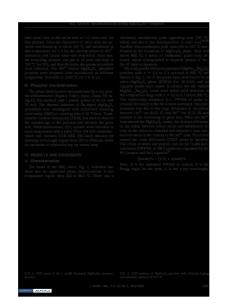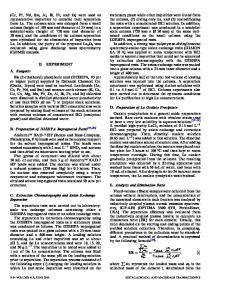New red-emitting Li 3 Bi 3 Te 2 O 6 :Eu 3+ phosphors with high color purity for white light-emitting diodes
- PDF / 2,031,175 Bytes
- 10 Pages / 595.276 x 790.866 pts Page_size
- 88 Downloads / 311 Views
New red-emitting Li3Bi3Te2O6:Eu3+ phosphors with high color purity for white light-emitting diodes Bin Deng1,3,* , Huan-you Wang1,3, Jun Chen1,3, Chong-song Zhou1,3, Hui Liu1,3, Jin Zhao4, and Gong-guo Zhang2,* 1
College of Chemistry & Biology and Environmental Engineering, Xiangnan University, Chenzhou 423043, Hunan, People’s Republic of China 2 Department of Chemistry and Chemical Engineering, Jining University, Qufu 273155, Shandong, People’s Republic of China 3 Hunan Provincial Key Laboratory of Xiangnan Rare-Precious Metals Compounds Research and Application, Chenzhou 423043, Hunan, People’s Republic of China 4 College of Science, Xi’an University of Architecture and Technology, Xi’an 710055, Shaanxi, People’s Republic of China
Received: 25 March 2020
ABSTRACT
Accepted: 27 October 2020
This work is the first to synthesize the red-emitting Li3Bi3Te2O6 phosphors using the conventional high-temperature solid-state reaction. The phase purity, particle morphology, and luminescent properties are analyzed in detail. Upon the near-ultraviolet (n-UV) excitation on 395 nm, Li3Bi3Te2O6:Eu3? phosphors show four emission peaks due to 5D0 ? 7FJ (J = 1, 2, 3, 4) transitions and the strongest peak is at 610 nm (5D0 ? 7F2). The best doping concentration of Eu3? ions is found to be 0.45 mol. The critical transfer distance (Rc) of the energy transfer ˚ and the luminescence quenching is conbetween the Eu3? ions reaches 11 A firmed by the nearest-neighbor ions interaction. The commission international de l’Eclairage (CIE) chromaticity coordinates (0.655, 0.344) of Li3Bi3Te2O6:0.40Eu3? phosphors are in the red region. The values of decay time are calculated in the millisecond time range from 0.878 to 0.493 ms. Phosphors show common thermal stability with activation energy (0.25 eV). All the properties indicate that Li3Bi3Te2O6:Eu3? phosphors have potential applications in displays and photonic devices.
Ó
Springer Science+Business
Media, LLC, part of Springer Nature 2020
1 Introduction As an ideal lighting source, white light-emitting diodes (w-LEDs) attracted researchers with excellent characteristics such as good environmentally
friendly, high brightness, long working lifetime, and high efficiency compared to other traditional solidstate lightings [1–5]. The phosphors played an important role in the development of w-LEDs [6, 7]. At present, the commercial w-LEDs were mainly
Bin Deng and Huan-you Wang have contributed equally to this article.
Address correspondence to E-mail: [email protected]; [email protected]
https://doi.org/10.1007/s10854-020-04767-9
J Mater Sci: Mater Electron
fabricated by a method of combining blue InGaN chip and yellow phosphors Y3Al5O12:Ce3? [8]. Nonetheless, these products lacked red composition. It also caused some problems such as poor Ra (Ra & 70 * 80) and high CCT (CCT [ 4500 K), which restricted the development of w-LEDs in the future [9]. To overcome these disadvantages, an alternative useful method was blended n-UV chips with green-, red-, and blue-emitting phosphors for w-LEDs [10].
Data Loading...











